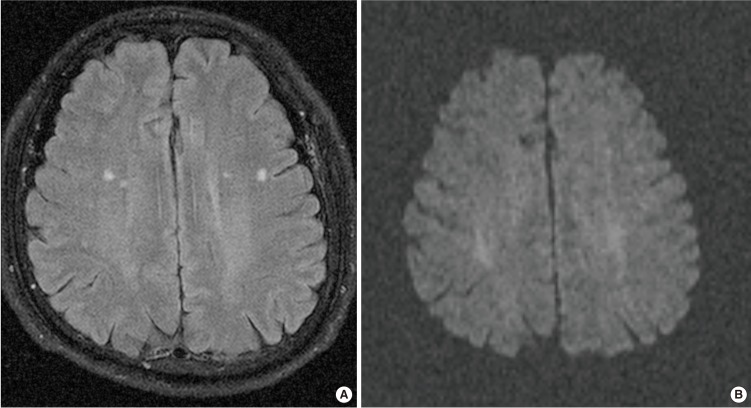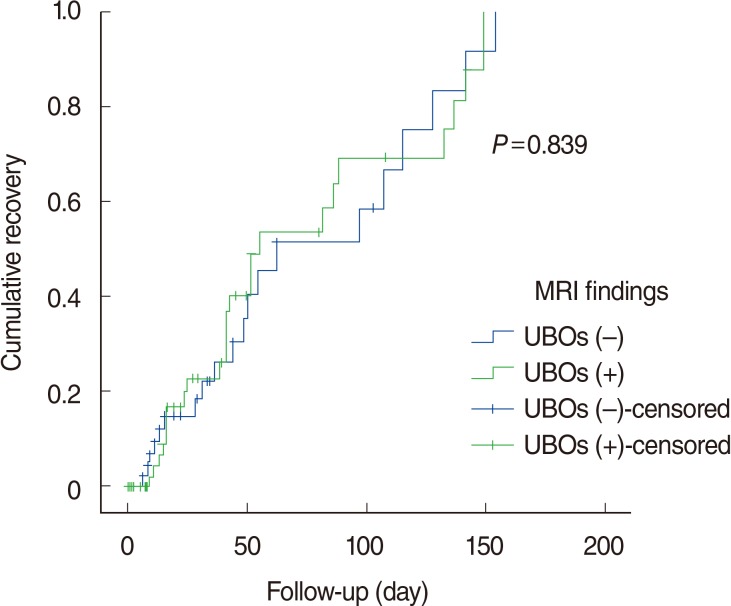Clin Exp Otorhinolaryngol.
2015 Dec;8(4):364-369. 10.3342/ceo.2015.8.4.364.
Unidentified Bright Objects on Brain Magnetic Resonance Imaging Affect Vestibular Neuritis
- Affiliations
-
- 1Department of Otorhinolaryngology, Eulji University Hospital, Eulji University School of Medicine, Daejeon, Korea. hoyun1004@gmail.com
- KMID: 2128911
- DOI: http://doi.org/10.3342/ceo.2015.8.4.364
Abstract
OBJECTIVES
The aim of this study was to investigate the differences in clinical manifestations of in two groups of vestibular neuritis (VN) patients with or without unidentified bright objects (UBOs).
METHODS
A prospective, observational study with 46 patients diagnosed with VN between May 2013 and November 2013 was executed. A caloric test, a cervical vestibular-evoked myogenic potentials (cVEMPs) test, brain magnetic resonance imaging (MRI), spontaneous nystagmus test, head impulse test, and head-shaking nystagmus test were performed.
RESULTS
Of the patients, 56.5% (n=26) were classified as UBO-positive by MRI. These showed lower caloric weakness and more prominent cVEMP asymmetry compared with the UBO-negative group (P<0.05). Total VN (TVN) was the most common in the UBO-positive group (45.0%), followed by superior VN (SVN, 30.0%), and inferior VN (IVN, 25.0%). However, in the UBO-negative group, SVN (75.0%) was the most common, followed by TVN and IVN (P<0.05). The recovery rate was not influenced by UBOs (P>0.05).
CONCLUSION
UBOs on T2-weighted or fluid attenuated inversion recovery MRI may affect the patterns of the vestibular nerve in patients with VN.
MeSH Terms
Figure
Reference
-
1. Brandt T, Dieterich M, Stroupp M. Vertigo and dizziness: common complaints. 2nd ed. London: Springer;2013.2. Jeong SH, Kim HJ, Kim JS. Vestibular neuritis. Semin Neurol. 2013; 7. 33(3):185–194. PMID: 24057821.
Article3. Curthoys IS. The interpretation of clinical tests of peripheral vestibular function. Laryngoscope. 2012; 6. 122(6):1342–1352. PMID: 22460150.
Article4. Colledge N, Lewis S, Mead G, Sellar R, Wardlaw J, Wilson J. Magnetic resonance brain imaging in people with dizziness: a comparison with non-dizzy people. J Neurol Neurosurg Psychiatry. 2002; 5. 72(5):587–589. PMID: 11971042.
Article5. Ferraz-Filho JR, Jose da Rocha A, Muniz MP, Souza AS, Goloni-Bertollo EM, Pavarino-Bertelli EC. Unidentified bright objects in neurofibromatosis type 1: conventional MRI in the follow-up and correlation of microstructural lesions on diffusion tensor images. Eur J Paediatr Neurol. 2012; 1. 16(1):42–47. PMID: 22088602.
Article6. Pantoni L, Garcia JH. Pathogenesis of leukoaraiosis: a review. Stroke. 1997; 3. 28(3):652–659. PMID: 9056627.7. Oishi M, Mochizuki Y. Regional cerebral blood flow and cerebrospinal fluid glutamate in leukoaraiosis. J Neurol. 1998; 12. 245(12):777–780. PMID: 9840349.
Article8. Welker KM, De Jesus RO, Watson RE, Machulda MM, Jack CR. Altered functional MR imaging language activation in elderly individuals with cerebral leukoaraiosis. Radiology. 2012; 10. 265(1):222–232. PMID: 22891355.
Article9. Mascalchi M, Inzitari D. Leukoaraiosis: a reappraisal. II. MRI studies. Ital J Neurol Sci. 1991; 6. 12(3):271–279. PMID: 1874605.
Article10. Kim HA, Lee H. Recent advances in central acute vestibular syndrome of a vascular cause. J Neurol Sci. 2012; 10. 321(1-2):17–22. PMID: 22906582.
Article11. Balatsouras DG, Koukoutsis G, Ganelis P, Economou NC, Moukos A, Aspris A, et al. Benign paroxysmal positional vertigo secondary to vestibular neuritis. Eur Arch Otorhinolaryngol. 2014; 5. 271(5):919–924. PMID: 23575935.
Article12. Rohrmeier C, Richter O, Schneider M, Wirsching K, Fiedler I, Haubner F, et al. Triple test as predictive screen for unilateral weakness on caloric testing in routine practice. Otol Neurotol. 2013; 2. 34(2):297–303. PMID: 23444477.
Article13. Park HJ, Shin JE, Lee YJ, Park MS, Kim JM, Na BR. Hyperventilation-induced nystagmus in patients with vestibular neuritis in the acute and follow-up stages. Audiol Neurootol. 2011; 5. 16(4):248–253. PMID: 20980745.
Article14. Murofushi T, Kaga K. Vestibular evoked myogenic potentials: its basics and clinical applications. Tokyo: Springer;2009.15. Smith EE. Leukoaraiosis and stroke. Stroke. 2010; 10. 41(10 Suppl):S139–S143. PMID: 20876490.
Article16. Arsava EM, Rahman R, Rosand J, Lu J, Smith EE, Rost NS, et al. Severity of leukoaraiosis correlates with clinical outcome after ischemic stroke. Neurology. 2009; 4. 72(16):1403–1410. PMID: 19380699.
Article17. Caprio FZ, Maas MB, Rosenberg NF, Kosteva AR, Bernstein RA, Alberts MJ, et al. Leukoaraiosis on magnetic resonance imaging correlates with worse outcomes after spontaneous intracerebral hemorrhage. Stroke. 2013; 3. 44(3):642–646. PMID: 23391853.
Article18. Srikanth V, Beare R, Blizzard L, Phan T, Stapleton J, Chen J, et al. Cerebral white matter lesions, gait, and the risk of incident falls: a prospective population-based study. Stroke. 2009; 1. 40(1):175–180. PMID: 18927448.19. Masdeu JC, Wolfson L. White matter lesions predispose to falls in older people. Stroke. 2009; 9. 40(9):e546. PMID: 19628802.
Article20. Strupp M, Brandt T. Vestibular neuritis. Semin Neurol. 2009; 11. 29(5):509–519. PMID: 19834862.
Article21. Halmagyi GM. Diagnosis and management of vertigo. Clin Med. 2005; Mar-Apr. 5(2):159–165. PMID: 15847010.
Article22. Baloh RW, Kerber KA. Clinical neurophysiology of the vestibular system. 4th ed. New York: Oxford University Press;2011.23. Kim JS, Kim HJ. Inferior vestibular neuritis. J Neurol. 2012; 8. 259(8):1553–1560. PMID: 22215238.
Article24. Goudakos JK, Markou KD, Franco-Vidal V, Vital V, Tsaligopoulos M, Darrouzet V. Corticosteroids in the treatment of vestibular neuritis: a systematic review and meta-analysis. Otol Neurotol. 2010; 2. 31(2):183–189. PMID: 20009780.25. Gianoli G, Goebel J, Mowry S, Poomipannit P. Anatomic differences in the lateral vestibular nerve channels and their implications in vestibular neuritis. Otol Neurotol. 2005; 5. 26(3):489–494. PMID: 15891655.
Article26. Goebel JA, O'Mara W, Gianoli G. Anatomic considerations in vestibular neuritis. Otol Neurotol. 2001; 7. 22(4):512–518. PMID: 11449110.
Article27. Cummings CW, Haughey BH, Thomas JR, Harker LA, Flint PW. Cummings otolaryngology-head and neck surgery. 4th ed. St. Louis: Elsevier;2005.
- Full Text Links
- Actions
-
Cited
- CITED
-
- Close
- Share
- Similar articles
-
- A Case of Selective Inferior Vestibular Neuritis Showing Normal Caloric Test
- Correlation Between Unidentified Bright Objects on Brain Magnetic Resonance Imaging (MRI) and Cerebral Glucose Metabolism in Patients with Neurofibromatosis Type 1
- A Case of Isolated Nodular Infarction Mimicking Vestibular Neuritis on the Contralateral Side
- Isolated nodular infarction and vestibular neuritis
- Vestibular Neuritis of Vascular Cause




